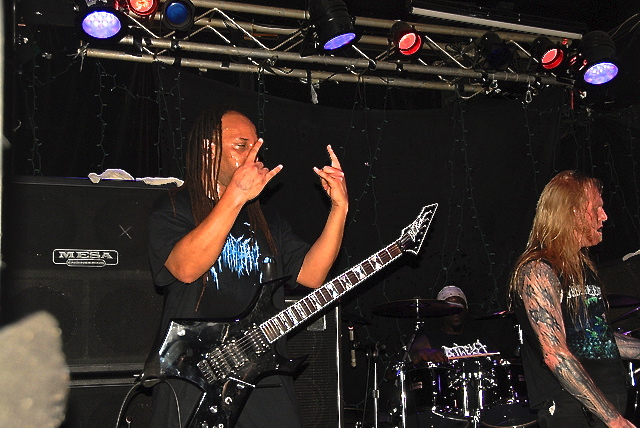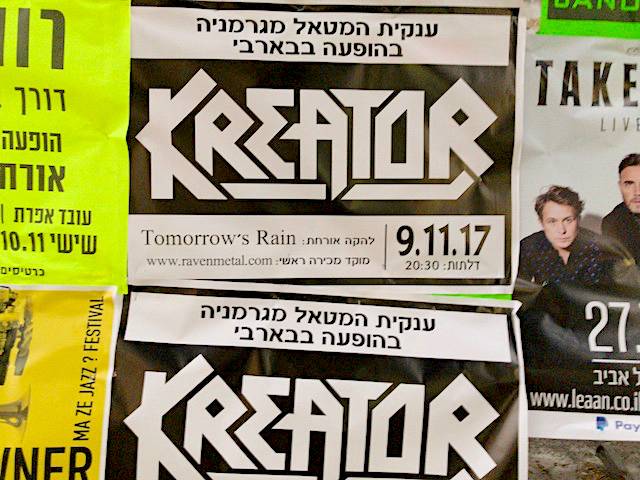There’s always one or two at every metal gig I go to in London. Amid the sea of white faces there are always one or two black fans standing out from the crowd. The question I want to ask is “What are you doing here?” Not because I don’t think black people should be into metal, but because I want to know what drew them to heed metal’s call.
Reading Laina Dawes’ book What Are You Doing Here? A Black Woman’s Life and Liberation in Heavy Metal I found my curiosity about black metal fans both validated and rejected. Validated because the very fact of a black woman writing a book about her own and others experiences in the metal scene suggests that this is an ‘issue’, a question that needs to be answered. Rejected because asking ‘what are you doing here?’ reinforces black people’s otherness in metal.
At one level, Dawes demonstrates that the answer to the question is totally unsurprising. Black women (and by extension black men) like metal for the same reason anyone else does. For some human beings, metal simply strikes a nerve; it allows them to find meaning, to deal with intense emotions, to find pleasure in a complex world. Nothing in Dawes’ book suggests that black female metal fans are anything out of the ordinary save in their determination not to be put off.
But turn the question on its head and things get more complicated. Why do so few black people seem to like metal? As Dawes shows, there are practices of exclusion and self-exclusion that mean that only small numbers follow her path. Not only does direct racism play an important role, but the very surprise that greets the putative black metal fan can be intimidating even when it is well intentioned. Dawes’ interviews with black female metal musicians shows how black women can be treated as exotic novelties in the metal scene. While a few thrive on this, it takes guts to walk into a metal show as the only black woman – not everyone wants to stand out.
Then there is the powerful force of black musical cultures which, since at least the late sixties, have turned away from rock towards other musical forms. Black people themselves can and do look at black metal fans with curiosity and even scorn.
Dawes’ experiences and the experiences of other black women in metal she talks to in the book, show how much to be black is to be confronted with a burdensome set of expectations as to what one should like and how one should act. As someone who was adopted by a white family in the largely white Canadian town of Kingston, she knows what it is like to feel pressure to conform to a particular racial model. As Dawes explains, her love of metal is often explained away as the result of being ‘raised white’, making her not ‘really’ black.
What Are You Doing Here does metal a valuable service by highlighting the ways metal scenes are racialised. Dawes tries to raise the racial consciousness of the metal scene that she so clearly loves. She draws attention to the work of some interesting black female musicians and shows that black heavy metal did not begin or end with Living Colour.

Still, I can’t help thinking that Dawes could have gone further in her argument. The situation with regard to metal and blackness is both worse and better than she implies.
Why worse? Consider this:
In the last 2-3 decades, metal has become incredibly diverse globally. There are strong metal scenes throughout the world and even those long hold-outs, India and China, now have burgeoning metal cultures. Moreover, bands around the world have incorporated a wide range of ‘folk’ musics and local influences into their sound. Yet, with one exception (Botswana), black sub-Saharan Africa and the black Caribbean are almost entirely metal free. Even in cosmopolitan cities like London, where one can hear dozens of languages at metal gigs, black people are the most striking absence.
Metal emerged from the blues, yet since the 1970s any trace of black musical influence has been systematically removed to the point where Hendrix and Led Zeppelin have only a qualified place in the metal canon. It’s no coincidence that the most loathed metal sub-genre, nu metal, is also the one that has been most active in incorporating black (principally rap) musical influences. Metal today fuses with a vast range of musical styles – but it is black styles that attract controversy.
There is no doubt then that exclusion of blackness is a fundamental element of metal. The experiences that Dawes recounts are the tip of the iceberg.
Yet as I said, the situation is better than it might seem. Consider this:
Metal may be strongly coded as ‘not black’, but its coding as ‘white’ has become seriously eroded, (despite the efforts of metal’s openly racist fringe.) In fact there is good cause to go further and conclude that metal is now one of the most diverse and cosmopolitan global music scenes.
Metal does not ‘have to’ incorporate blackness to be politically and musically valid. Not everything has to include everything. Schlager does not need to incorporate the music and experience of Laotians, Soca does not need to incorporate the music and experience of Slovenians.
What metal does need to be is open to the involvement of those black people who wish to join. As Dawes shows, there are many barriers here, subtle and not so subtle. But Dawes’ experience as a writer not just of this book but also for a number of metal publications, also shows that the glass ceiling can be broken. Black men and women can and do get involved in metal scenes and be treated with respect and equality.
One of the reasons why this is possible – and why, as I say, the situation is better than it might seem – is because metal has a strong ethic of togetherness that binds that metal world together. Being a committed fan and metal scene member can overcome all kinds of barriers. True, the initial entry into metal may be harder for black women than almost anything else, but once through the door things get a lot better.
Hopefully Dawes’ book will help erode barriers to black women’s entry into metal even further. Perhaps we are near a tipping point when the last remaining citadel holding out against metal’s global dominion will fall. Perhaps having more black people in metal scenes and making music will reconfigure what ‘black music’ means. Perhaps the exclusion of what we currently think of as black music will give way to the inclusion of a form of black music we cannot now even envisage.
Photographs courtesy of Metal Chris and twosandthrees.Published under a Creative Commons license.






bell hooks has been discussing ad finem how Black entertainers are exoticized for capitalist gain by the music industry for profit. This hijacks the ability of observers to see the real talent and for the entertainer to perform and to be acknowledged for their talent. She has an introduction and 8 sessions discussing pedogogy and cultural representations, and the “politics of difference”. http://www.youtube.com/watch?v=zQUuHFKP-9s
“but it is black styles that attract controversy.”
http://www.bigearsfestival.com/2010/wp-content/uploads/2010/02/liturgy_500x300.jpg
Yeah, totally.